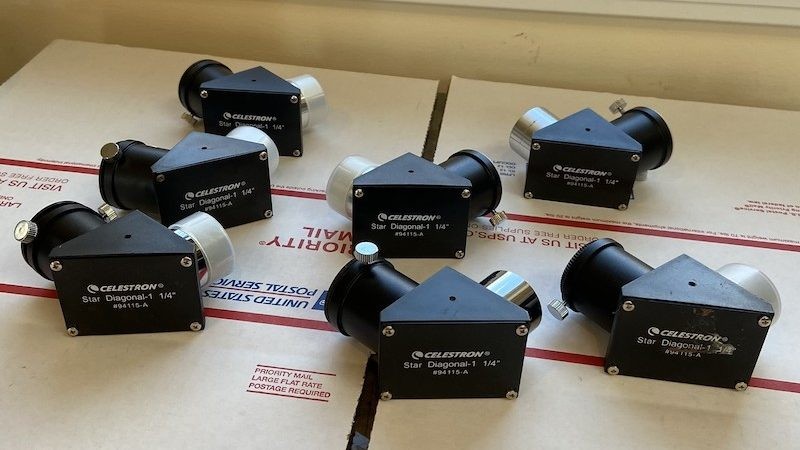
Star diagonals are a necessary part of any Cassegrain or refracting telescope that places its eyepiece at the back end. Without one, we literally might not be able to use our telescope comfortably, as the eyepiece may not be physically accessible or able to reach focus.

I’ve noticed that diagonals are often overlooked, but they’re tremendously important for achieving sharp views. I’ve come across diagonals with poorly polished optical surfaces inducing scattering and warping the image with aberrations like astigmatism. Cheap diagonals with low reflectivity can also dim the image through our telescope.
Whenever I’m concerned about them affecting sharpness, I usually adapt a better diagonal to the back-end port—though I always check for any clearance issues with the mount first.
Most telescopes that need a star diagonal come with one supplied, but I’ve often found most of those to be low quality or only in the smaller 1.25” format. A few telescopes have built-in “flip mirror” diagonals, which can often be just as disappointing.
Prism vs. Mirror Diagonals: Which To Choose?
Diagonals use either a mirror or a prism to bend light at a 90° angle. But they are still very different:
- In my experience, prism and mirror diagonals can both achieve excellent light transmission. Even the cheaper units sold today usually have 93% or better transmission, and all of the units I recommend later down the article are 98% efficient or better.
- The biggest difference in performance I’ve observed is that prisms scatter light less than mirrors and thus can produce a slightly sharper image on bright targets like planets. However, in refracting telescopes with fast focal ratios of f/6 to f/7 or faster, I’ve noticed prisms adding a bit of additional chromatic aberration to the view.
- Though rare, mirror diagonals can go out of collimation if dropped, but I can usually readjust it to fix the problem.
- I love that the prism diagonals’ solid prism optics essentially “seal off” a telescope tube when they are installed in a focuser. This makes them a little more rugged and ideal for use in dusty and dirty environments, especially if we’re using a more expensive instrument.
- While a niche concern, when I’m using night vision eyepieces, I prefer a prism diagonal because prisms transmit the near-infrared light picked up by night vision devices significantly better than aluminum mirrors. However, silver dielectric mirrors are available for this purpose as well.
- Prism diagonals are rarely available in 2” format, and those that are tend to be heavy and expensive.
Astronomical prism star diagonals use a triangular prism and should not be confused with Amici “erecting prism” and other designs that can be used for terrestrial observing. Amici prisms produce annoying diffraction spikes and other effects on astronomical objects, and cheap ones are often supplied with beginner telescopes. Only few are suitable for astronomy.
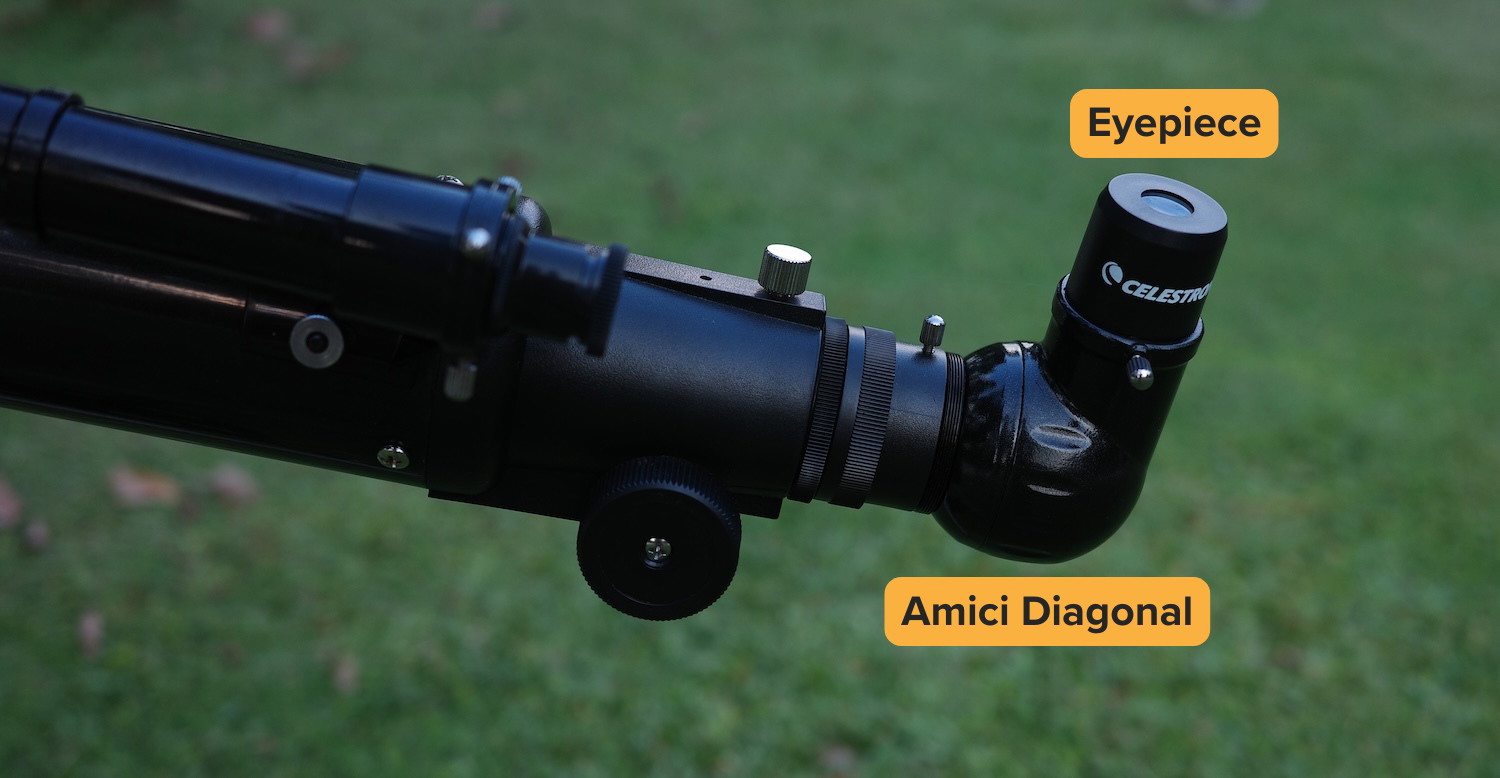
Size Consideration: 2” or 1.25”?
While using a 2” diagonal with any scope that can physically accept it would be nice, in reality, I’ve found this isn’t always beneficial.
With a heavy 2” diagonal and eyepieces, some telescopes may be unable to both clear their fork mounts with proper balance or simply be unable to balance on their mount entirely. The added weight alone could be too much for smaller and less-than-steady mounts. Also, even if smaller catadioptric telescopes with apertures less than 8″ may be able to physically fit a 2″ diagonal, their baffle tubes often limit the usable field of view to that of a 1.25″ format eyepiece to avoid vignetting.
Different Eyepiece Grips To Consider
Most good star diagonals use either a compression ring or a rotating-lock adapter to grip our eyepieces. The reasoning for using these instead of a simple set screw is that a tripod-mounted telescope, especially when on an equatorial mount, can have the eyepiece at angles where it could fall out due to an improper grip, whereas telescopes like Dobsonians usually have gravity to help as a backup should we screw something less-than-tightly. Set screws can also cause cosmetic damage from digging into the eyepiece.
Twist-lock diagonal designs are usually a little more secure than brass compression rings but are usually more expensive and slower to interchange eyepieces with.
Best Mirror Star Diagonal: Our Recommendations
If you’re using a 2” star diagonal, it’s likely to be a mirror diagonal. Dielectric mirrors have extremely durable coatings with many protective layers to minimize scatter and make them nearly impossible to scratch or chemically damage. Most mirror diagonals I’ve seen without dielectric coatings were cheap and of low quality.
If you’re limited to a 1.25” format, I’d recommend you consider a prism diagonal instead of a mirror, as they are on average cheaper while delivering the same or better performance in most telescopes, as discussed above.
2” Mirror Star Diagonals
1. Best In Class 2″ Mirror Star Diagonal: Baader BBHS 2”
The Baader BBHS 2” Star Diagonal uses a silver-based dielectric mirror, which is slightly superior to standard aluminum mirror diagonals but just as durable. The main benefits I see are that there is slightly less scatter and slightly more even color transmission, making the view through the eyepiece slightly more vivid and perfect for even night-vision work.
The mirror is made of Sitall, a low-expansion ceramic design, for the smoothest possible polish and the least possible affectation from temperature.
The Baader diagonals can screw directly onto the back of a Schmidt-Cassegrain telescope with a minimum length for clearance purposes or fit in any 2” focuser, and this diagonal uses the Baader ClickLock system to securely center and grip your eyepieces.
2. Baader MaxBright 2”
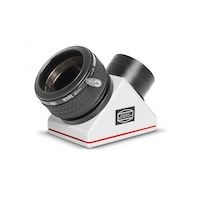
The Baader MaxBright 2” Star Diagonal has an extremely high-quality dielectric aluminum-coated Pyrex mirror and uses the Baader ClickLock system. However, you do need a separate 2” visual back or other adapter system to use this diagonal in a Schmidt-Cassegrain telescope.
3. Best Value 2″ Mirror Star Diagonal: Apertura 2″ Twist Lock
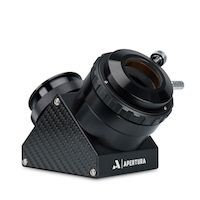
This diagonal uses cheaper BK7 glass for its mirror, but it still provides me sharp views and includes a twist-lock system and 1.25” adapters. The default version fits into a 2” focuser directly, but an SCT version of this diagonal is also available. The carbon fiber body is little more than an aesthetic choice, however.
4. Celestron 2″ Dielectric Star Diagonal with Twist-Lock
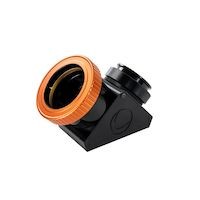
I’ve found the Celestron 2” Star Diagonal with Twist Lock to be similar in design and quality to the Apertura unit, though more expensive. It also uses a purely twist-lock system with no screws, which makes changing out eyepieces slightly faster, and comes with both SCT and 2” barrel adapters by default.
I Liked Takahashi 1/10th Wave Too, But Can’t Recommend
I’ve used the Takahashi 2″ Star Diagonal, and its huge body uses an elliptical mirror, just like that of a Newtonian reflecting telescope, with theoretically more room for adjustment and less possibility of issues due to temperature-induced expansion and contraction. This diagonal, as I’d expect, is made to excellent quality control standards.
However, it only uses a single thumbscrew to grip eyepieces, is quite bulky, and may have clearance problems on Schmidt-Cassegrain telescopes. In my experience, I didn’t get a ton of bang for my buck.
My Satisfiable Experience with TeleVue Everbrite 2″ Mirror Diagonal
The Tele-Vue Everbrite 2” Star Diagonal is another great choice I’ve found for a quality dielectric diagonal and includes 1.25” and SCT adapters by default. The standard single-screw compression ring grips are, however, not quite as secure as a twist-lock or ClickLock system.
1.25” Mirror Star Diagonals
1. Best Performance 1.25″ Mirror Diagonal: Tele Vue 1.25″ 90° Everbrite
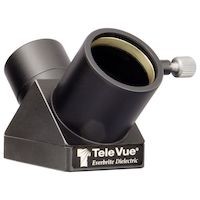
The Tele-Vue 1.25” Everbrite Mirror Star Diagonal uses a high-quality dielectric Pyrex mirror with 99% transmission, just like the larger 2” Everbrite. It also has a compression ring to grip our eyepieces.
For those who must have a Tele-Vue unit but are on a budget, the cheaper Tele-Vue 1.25” Enhanced Aluminum Star Diagonal have 3% lower reflectivity coatings than the Everbrite but is otherwise identical.
2. Best Value 1.25″ Mirror Diagonal: Apertura 1.25″ Carbon
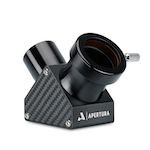
The Apertura 1.25” Carbon Dielectric Mirror Star Diagonal lacks the roto-locking eyepiece grip I’ve seen on its larger 2″ cousin but otherwise is similar in design and quality standards. The carbon fiber body and tapered eyepiece holder are really only aesthetic choices.
This diagonal probably provides the best value for your money of all the 1.25” dielectric diagonals, though a prism unit may make more sense.
3. Second Best Value: Celestron 1.25″ Dielectric

The Celestron 1.25″ Dielectric Star Diagonal is much like the Apertura dielectric diagonal, with the same BK7 mirror and 99% reflectivity, but uses a twist-locking mechanism instead of compression ring to grip our eyepieces.
4. Best Budget 1.25″ Mirror Diagonal: SVBONY SV188P
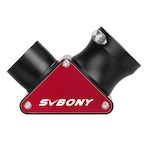
The SVBONY SV188P Dielectric Mirror Star Diagonal is similar to the Apertura unit but isn’t subject to quite the same quality control standards. The mirror is still BK7 and usually works fine but may not be quite as smooth and sharp. I’ve seen some users also reporting a failure to paint the inside of the anodized red housing of the diagonal black from the factory, leading to reddish glare on bright targets.
5. Cheapest: SVBONY 1.25″ 90° Zenith

The SVBONY 1.25” Aluminum Star Diagonal doesn’t have as much in the way of transmission, durability, or quality control standards compared to a more expensive diagonal. However, it doesn’t use any plastic parts, features a compression ring, and still achieves sharp images. I know of many far-worse budget options.
Best Prism Star Diagonals: Our Recommendations
2” Prism Star Diagonals
Best Performance 2″ Prism Diagonal: Baader 2” BBHS
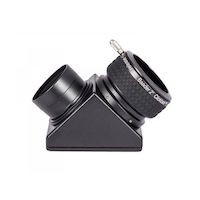
I’d consider the Baader 2” BBHS Prism Star Diagonal to be a bit of a niche product given that the silvered Sitall mirror diagonal from Baader is nearly identical in performance, although it has slightly more scatter. However, I think both are great choices.
Best Amici 2″ Diagonal: Baader 2″ Astro Amici
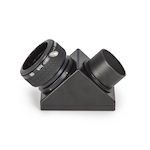
The Baader 2” Astro Amici is one of the few Amici prisms I would actually recommend if you must have a correctly oriented left-right, up-down system. It has extremely sharp optics on account of the prism being made by Zeiss and Baader’s high-quality coatings. However, I admit the price is a bit of a shocker, and it really offers me very little in the way of advantages over the standard BBHS prism or mirror diagonals.
1.25” Prism Star Diagonals
1. Best 1.25″ Prism Diagonal: Baader T2 Prism
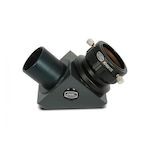
I’d say the Baader T2 Prism Star Diagonal is probably the best 1.25” prism diagonal around.
It uses interchangeable threads, which allows me to secure the diagonal to a telescope with other accessories for maximum clearance and as little spacing as possible. The T2 Prism also has a fine-focus adjustment built into its compression ring eyepiece holder, which I find extremely convenient for high-power planetary viewing.
The optics are, of course, top-notch too, with maximum light transmission and minimal scatter.
Best Value: Celestron 94115-A Prism
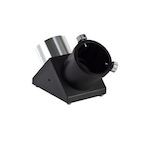
The Celestron #94115-A Prism Star Diagonal is the same diagonal that comes with many of Celestron’s mid-range and expensive telescopes when the cheap plastic Amici prism is not included.
The 94115-A has some plastic innards but uses a metal body, and the prism is of excellent quality, especially for the price.
The only issue I’ve encountered is that it uses thumbscrews to grip my eyepieces, and these screws are so short and fat that they can prevent me from inserting wider eyepieces all the way; thankfully, I can remedy this with a trip to the hardware store.

Awesome concensus!
While the amici diagonal from Baader is showing amateurs the sky as it should be, correct, this diagonal is best for correct view deep sky objects. For bright objects it basically cannot be used. The best correct views of bright objects requires a binocular telescope with superior optics.
Thanks so much for this article! I just purchased my first “nice” truly high quality telescope, a SkyWatcher 102mm Mak, and was reading up on just such diagonal upgrades as you describe here. I went with the SVBONY SV188P Red, as most of the others here would have cost as much or more than my new Mak! So thanks for including them in the Budget class… I’ll let you know how it goes.
Question: this is such an infrequent discussion, perhaps you could add something here about the OEM diagonals, both prism and dielectric mirror, which actually come with some of the current telescopes (such as SkyWatcher, Celestron or even Orion), For example, the are no markings on the SkyWatcher diagonal, it appears to be a mirror, and I must admit it does yield pretty good views… It will be interesting to see how the Red SVBONY compares. At 99%+ reflectivity – I’m expecting it would be better, But we shall see.
Thanks again,